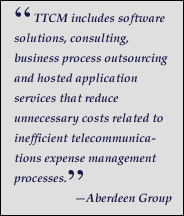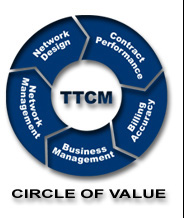




TTCM Savings Area:
Network Performance
Published In: Volume
3 Issue 3
Date: July,
2004
|
In advanced networks such as Frame Relay, ATM and MPLS the term "optimized" can mean many different things to different people. We believe that network optimization occurs at three levels:
Answering those
questions will often require some fairly deep analysis of multiple
information sources. Here are a few examples of critical questions
you can ask internally that will help you determine your level of
optimization in these 3 areas.
Problems of under-capacity are pretty easy to recognize, either through proactive efforts of network management or from the complaints that come rolling in from the user community. But the problem of over-capacity often remains invisible and causes companies to overpay for services. Many companies establish the requirements for their network when they first install it, but over time their needs change. The problem occurs when elements of the network are not brought into sync with current demands. Most telecom contracts provide the flexibility to change, either to increase or decrease capacity, and we highly recommend that companies invest the time to reconcile current needs with services being provided by the vendor. Burst rates, port speeds, etc. can often be modified to match your current needs. The result of that effort could be significant cost reductions.
Within the carrier's network you might unknowingly have multiple DS0s, DS1s or even DS3s that ride on a common transport system, even when the carrier has access to multiple systems in parallel. We're not saying the carrier is lazy, but it does take a little more work for them to provision across multiple transport systems, and so many times it just doesn't get done. The result is a very high degree of exposure with respect to continuity issues that can quickly isolate critical locations from the network as opposed to simply reducing throughput until the problems have been resolved. Finding these situations is contained in the carrier's Customer Service Records (CSRs), Circuit Layout Reports (CLRs) or in other cryptic documents. If you have not evaluated the actual provisioning of your network within the carrier's cloud, you may have significant exposure. Another aspect of continuity relates to network protection. We all too often find situations where the customer believes that a certain level of network protection is contained in their service agreement. An analysis of the CSRs, contracts, etc. often demonstrates otherwise, revealing a significant element of risk.
LEC based services are still regulated by tariffs, but all tariffs are certainly not equal. You can be charged any number of different tariffed rates for the exact same service. As an example, rates for services that carry Interstate traffic are different than rates for services that exclusively carry Intra-LATA traffic. The LECs will assign a particular tariff, and it is very common for that tariff to be higher than a different tariff you are entitled to file under. That overcharge becomes an accepted cost of business and can continue indefinitely unless it is rooted out. A thorough review of the tariffs you are being charged, mapped against the actual usage of your services, can identify a number of savings opportunities. And when the carrier is in error, you will be owed recoveries as well. LEC's often use the same USOC codes for multiple port or PVC speeds, or for similar services between states, which will often result in improper charges being applied.
Maintaining an optimized network is the essential foundation element for performance and cost control. If you haven't recently reviewed your network in the context of the points made above we recommend doing so as part of your overall telecom management responsibility.
©2004,
TelAssess, Inc. All rights reserved. |
![]()
©2004, TelAssess 800.657.1595
Designed by Stylus
Designs

